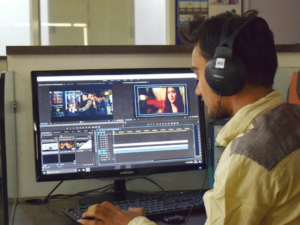Blog post, we will explore the concept of light and shadow in audiovisual media and how the strategic use of these tools can help to create an effective narrative.
1. Understanding the impact of lighting on a subject
Knowing how lighting affects a subject is essential in creating a powerful narrative in audiovisual media. By understanding how light moves in a space, it can be manipulated to produce the desired effect. This may involve the use of absorbers, reflectors, diffusers, and other related equipment to create shadows where appropriate and direct the light in a way that highlights the subject and emotion of the scene. Lighting is a valuable tool in building an effective narrative, so it is essential to have a good understanding of how to use it strategically.
2. Use absorbent materials to reduce glare
When it comes to controlling light and shadows on a set, one of the most important pieces of equipment to consider is the absorber. These are materials that absorb certain frequencies of light and reduce unwanted reflections, thus contributing to shaping the overall look of the scene. Cinefoil, blackwrap, and duvetyne are all examples of absorbers commonly used in audiovisual media. When using absorbers, it is important to place them in the right positions and angles relative to the scene in order to achieve the desired result.
3. Controlling light intensity with reflectors
Reflectors are an essential tool when it comes to controlling the intensity of light in audiovisual media. By correctly positioning a reflector, a lighting technician can direct light where it is needed, increase or decrease its intensity, and even create desired effects and atmosphere with precision. In addition, reflectors can be used to enhance shadows and create depth, thereby adding an extra level of dimension to the scene.
4. Use diffusers to mitigate shadows
Diffusers are an important tool to soften shadows, creating a uniform light without hard edges. They can be used to modify the direction of the light, change its intensity, or reduce glare. Diffusers can be made from various materials, including translucent paper, fabric, or plastic, and are usually placed in front of a light source to disperse its rays. Diffusers are also helpful in reducing shadows and can be used to create a softer, more natural look.
5. Selecting the appropriate lighting devices
When it comes to lighting devices, there are a variety of types to consider. From incandescent bulbs to fluorescent and LED fixtures, you must choose the type that best suits your production needs. Depending on your budget and the desired effect, you can opt for low-power incandescent bulbs, which diffuse a warmer and softer light, or for fluorescent fixtures, which are energy-efficient and produce bright and uniform light. LED fixtures, although more expensive, emit a beautiful natural light that can be adjusted to different color temperatures. Whatever type of lighting device you choose, proper placement and the use of reflectors, absorbers, and diffusers will help you create the desired effect.
6. Create depth with shadows
Creating depth is a key objective when designing a scene. By using shadows, you can create the illusion of depth and separate the different elements of the scene. Shadows also add drama to a scene and can be used to highlight certain elements. The strategic use of light and shadows in audiovisual media – including film, advertising, and music videos – is essential for effective storytelling. This goal is achieved through the judicious use of absorbers, reflectors, diffusers, and other related equipment.
7. Use colored gels to create atmospheres
Colored gels can be used to create moods in audiovisual media. By attaching colored gels to lights, it’s possible to create warm or cool tones that can be used to convey different emotions. For instance, a red gel can be used to produce a feeling of intensity, while a blue gel can be used to create a more relaxing atmosphere. The use of colored gels in conjunction with other lighting equipment can effectively evoke emotions without relying too heavily on dialogue or the script.
8. Increase the lighting using digital effects
To enhance the impact of lighting in audiovisual media, digital effects can be used. These effects can bolster the atmosphere and ambiance of a scene, thereby creating a heightened sense of realism and engagement with the audience. Digital effects can also be used to simulate natural lighting, such as moonlight, sunlight, or even a thunderstorm. Digital effects can also be used to create lighting transitions and add texture elements for a dramatic effect. By utilizing digital effects in a creative manner, the lighting of a scene can be emphasized, which helps to create effective storytelling and captivate the audience.
In conclusion, the strategic use of light and shadow in audiovisual media is essential for creating an effective narrative. Whether it’s in films, advertisements, or music videos, appropriate lighting equipment such as absorbers, reflectors, and diffusers can help create the desired visual effect. With the right combination of shadow and light, filmmakers, advertisers, and music video directors can help viewers emotionally engage with their stories through the power of shadow and light.


